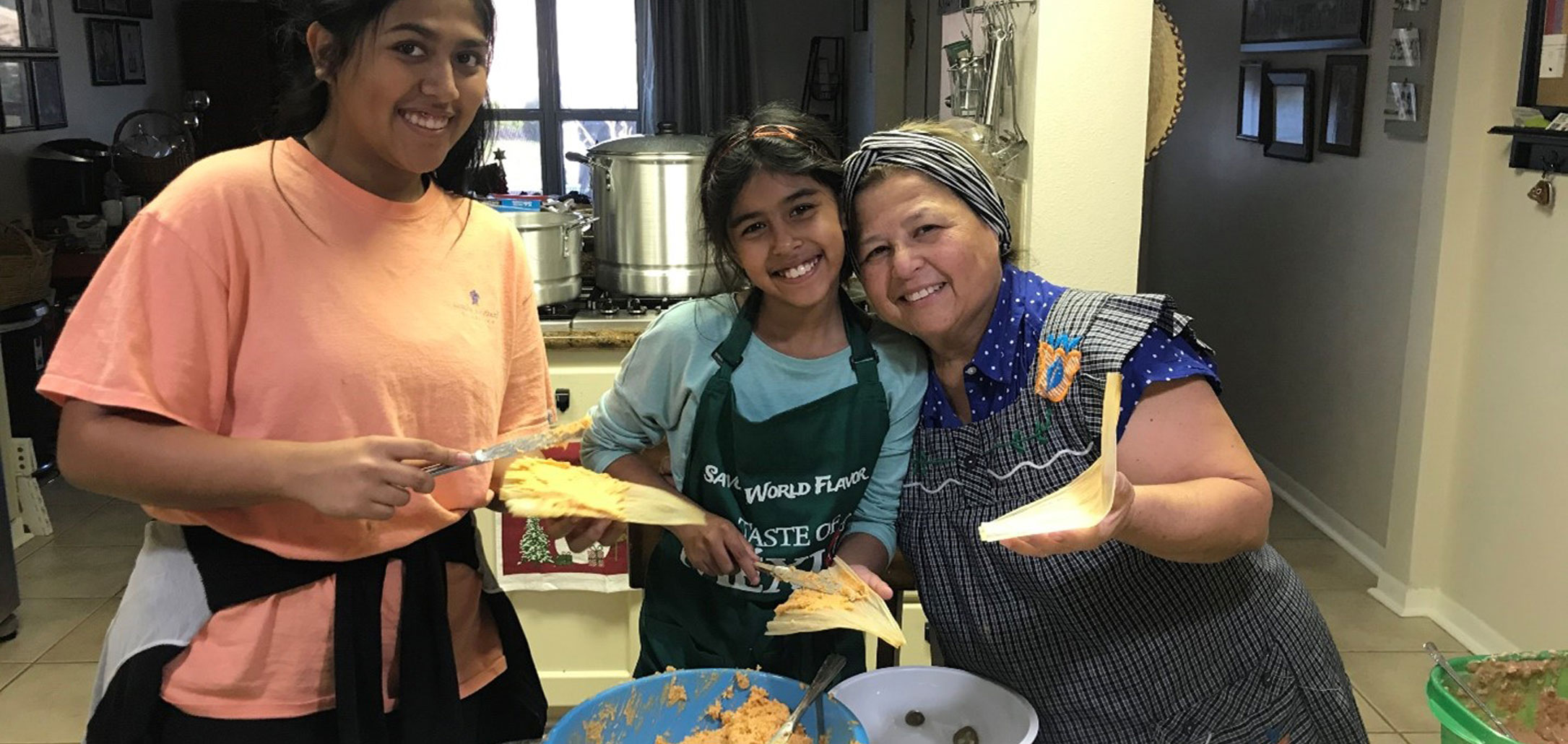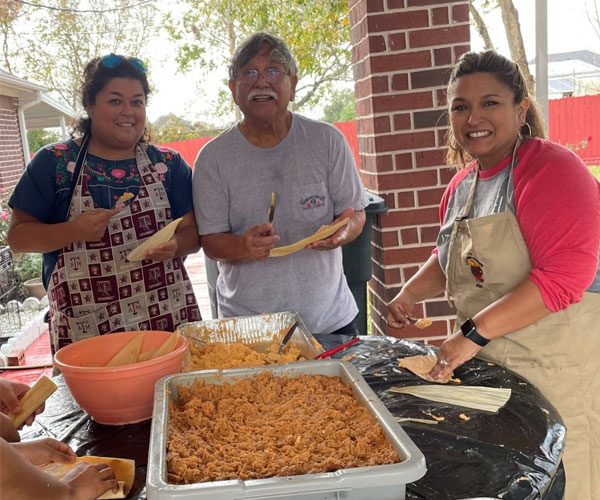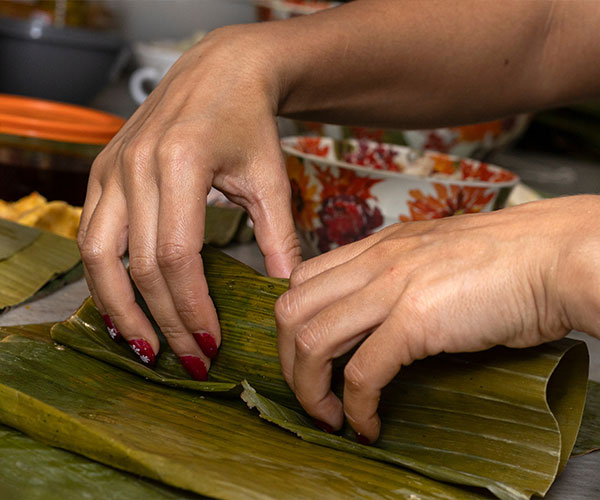
In the photo from left to right (Sofia (sister), Lily (sister), Sulema (Grandmother)
Tamales: A Taste of Tradition and Culture
by Mikaela Ustoy
As we celebrate Hispanic Heritage Month, the Nutrition Education and Health Promotion Team will be highlighting dishes that embody the rich history, culture, and culinary artistry of Latin America—starting with the tamal. Tamales have been a staple in Mesoamerican cultures for thousands of years, and they remain a beloved part of Hispanic cuisine today. From family gatherings to special celebrations, tamales offer a taste of tradition that connects generations.

My Favorite Tamale Memories
Some of my fondest memories involve gathering with my family and learning from my grandmother how to prepare and cook tamales. One of the most memorable moments was when I was finally skilled enough to be trusted with wrapping them. I had spent years watching my tías perfect the delicate balance of not too much masa and just the right amount of filling. While it took a few tries, I eventually got it.
But for me, it was never just about making the perfect tamale. It was the conversations we had while working together, dancing to music, sharing funny stories, and spending time with extended family. It was during these moments that I realized tamales aren’t just food—they are a way for us to stay connected and honor our culture.
Even now, with every bite of tamales, I can taste the beautiful history and culture of my family.

In this photo from left to right (Christina (Tia), Manuel (Grandfather), Cyndi (Mother)
The Cultural Significance of Tamales

Tamales date back to as early as 8000 BCE, with roots in the ancient civilizations of the Aztecs, Mayans, and Incas. These early peoples created tamales as portable, nutrient-dense meals that could be taken on the go—whether for warriors, hunters, or travelers. Wrapped in corn husks or banana leaves, tamales could be easily carried and eaten in the field, providing sustenance for long journeys or battles.
Beyond their practical origins, tamales have always played a central role in cultural and religious ceremonies. They were offered to the gods in rituals and feasts, symbolizing gratitude and abundance. Today, tamales are still a centerpiece during significant holidays and celebrations, including Christmas, Día de los Muertos, and family milestones.
Each region in Latin America has its own take on tamales. In Mexico, they’re typically made with a corn dough called masa, filled with meats, vegetables, or chilies, and wrapped in corn husks. In Central America, tamales might be wrapped in banana leaves, giving them a slightly different texture and flavor. These variations reflect the diversity and richness of Hispanic cultures, where food is not just sustenance but a way to preserve history and heritage.
The Art of Making Tamales
Tamales are more than just a meal—they’re an experience. Making tamales is often a family affair, where multiple generations come together to prepare and assemble them. This tradition, known as a “tamalada,” is a time of bonding, storytelling, and passing down recipes. It’s not just about cooking; it’s about community.
During a tamalada, tasks are divided among family members. One person prepares the masa, another arranges the fillings, and others wrap the tamales. The process is labor-intensive but filled with love and care. At the end of the day, sharing the tamales you’ve made with loved ones is a reward in itself.

Nutrition Information
While tamales are celebrated for their cultural significance, they also offer a variety of nutritional benefits, depending on the ingredients used. The masa, made from ground corn, is rich in carbohydrates and provides a good source of energy. Traditional fillings like pork, chicken, beans, or vegetables add protein, fiber, and essential vitamins. However, tamales can also be high in fat and calories, particularly if made with lard or fatty meats. For a healthier twist, try using leaner meats like chicken breast, or vegetarian fillings such as beans, roasted vegetables. Steaming the tamales, instead of frying, helps retain their nutritional value while reducing excess fat.
Celebrating Hispanic Heritage Through Food

Tamales
Ingredients
- •Corn Husks or tamales
Filling:
- 1 russet potato diced
- 2 carrots diced
- 2 chicken breasts cooked and shredded
- 1 tsp ground cumin
- 1 tbsp olive oil
- 1/4 onion julienned
- 1 tsp salt and peper
Masa:
- 2.5 cups of masa
- 1.25 cups chicken broth
- 1 tbsp salt
- 8 oz. pork lard
- 1 tbsp baking powder
Guajillo Salsa:
- 6 Guajillo peppers devined, deseeded, boiled and cleaned
- 2 pasilla peppers devined, deseeded, boiled and cleaned
- 1/4 onion roasted
- 3 cloves of roasted garlic
- 1/4 cup of chicken broth
- 1 tsp cumin
- 1 tsp salt and pepper
Instructions
- Start by soaking the corn husks in lukewarm water so that they get softer.
- Once soft, strain the water and set the husks aside.
- Then, fill the bottom part of the steamer with water and a little bit of salt, making sure that it doesn't reach the space where the tamales will be placed.
- Masa:
- Add all of the dry ingredients, including the lard, to a large bowl and mix well.
- Start adding the chicken broth a little at a time while stirring until a soft, malleable dough is formed.
- Filling:
- Sautee the onion and chicken with the spices and olive oil, set aside.
- Add the carrots to boiling water for 5 minutes.
- Then, add the potatoes and let everything boil together for an additional 10 minutes.
- The potatoes and carrots should still be pretty firm.
- Transfer the carrots and potatoes to a frying pan and cook with salt and pepper over medium heat for a couple of minutes.
- Set aside.
- Guajillo Salsa:
- Combine all of the ingredients in a blender and blend well.
- If it is still a little bit thick, strain the mixture and only use the strained liquid.
- Making and cooking the Tamales.
- Take two of the corn husks and overlap one on top of the other, leaving the end separated.
- Add 1/4 cup of the masa on top of the husks, then top with the chicken filling, the vegetables, and guajillo salsa.
- Assembly:
- Fold over like a gift, putting the seam down.
- Add to the steamer, and cook for 1 - 1.5 hours.
Notes
- In Mexico, tamales are a traditional food that date back to pre-Columbian times. Tamales have been found in Mesoamerican ruins that date back to 800 BC.
- They are made of corn dough that is filled with either meat or vegetables and then wrapped in a corn husk or banana leaf and steamed.
- Tamales are traditionally made with masa, a type of cornmeal dough, and filled with meats, cheese, or vegetables. They can be steamed or boiled.
- They are a great source of protein and fiber. One tamale can contain up to 20 grams of protein and 5 grams of fiber.


